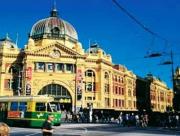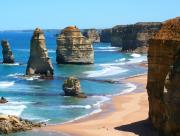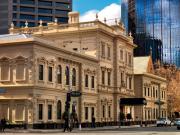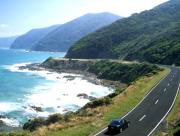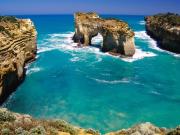Melbourne to Adelaide Itinerary
via The Great Ocean Road & Grampians.
Day 1: Melbourne to Apollo Bay
Distance 200km Approx drive time 3 hours
Depart Melbourne via the West Gate Bridge and follow the Princes Freeway towards Geelong. The historic Werribee Park Mansion and Point Cook National Aviation Museum are both accessible from the freeway or stop at Serendip Sanctuary, situated near the township of Lara. Over 150 species of birds have been recorded in the sanctuary and visitors can view this native wildlife at close range
Spend some time in Geelong visiting the National Wool Museum, which is housed in a century-old bluestone Woolstore, and documents Australia's wool industry from fleece to completed garments. Other features of this provincial city are the restored art deco Eastern Beach Baths Complex, and its newly developed waterfront and unique bollard sculptures.
Travelling on from Geelong you may detour along the Bellarine Peninsula and visit Port Lonsdale and Queenscliff. This historic town combines 19th century Victorian architecture with fisherman's cottages and is home to Australia's largest best preserved military fort. Breathtaking views of Port Phillip Bay can be seen from the "Rip" lookout at Point Lonsdale. From here it is a short drive to Torquay where the surf world Museum documents surfing history in the region. Along Bells Beach, Torquay is recognised among the world's premier surfing locations.
Continue on through the townships of Anglesea and Aireys Inlet to Lorne, a resort style town combining restaurants and shops with natural attractions such as the Angahook-Lorne State Park. Approaching Apollo Bay, the contrast between rugged coast and inland forest becomes more spectacular. This fishing and farming village is also an excellent base for exploring the waterfalls and rainforests in the Otway National Park.
Day 2: Apollo Bay to Port Fairy
Distance 200km Approx drive time 2 hours and 30 minutes
Continuing along the Great Ocean Road, and as it moves inland, you may wish to take a short detour and follow the signs to Cape Otway. This 13km drive winds through thick forest canopies to reveal waterfalls, native Australian animals and spectacular coastal views from the headland.
Back on the main road, the stretch of road from Lavers Hill onward is a highlight. It traces limestone cliffs along the "Shipwreck Coast" aptly named as more than 50 ships have run aground or struck reefs and sunk. The limestone rock formations have been carved away from the mainland over thousands of years. These natural monuments from a stunning panorama and include the Twelve Apostles, Loch Ard Gorge and London Bridge. Viewpoints are signposted with information boards, boardwalks and parking.
Nearing Port Campbell, the road passes by wetlands and estuaries which are inhabited by various species of birdlife. At Peterborough, you will ding other frock formations, such as the Bay of Martyrs and Bay of Islands.
Continue on to the city of Warrnambool, a one time whaling centre which now attracts visitors to observe the large mammals. Southern right Whales appear each year between May and September, and can be viewed from Logans Beach. Flagstaff Hill Museum is worth visiting to discover the town's maritime history. It is then a short drive to Tower Hill Nature Reserve where koalas, emus and kangaroos can often be seen. Final stop for today is Port Fairy, one of Victoria's earliest whaling ports. Many buildings date from the 1840s. The National Trust has classified dozens of them.
Day 3: Port Fairy to Grampians National Park
Distance 160km Approx drive time 2 hours
Retrace your drive yesterday back towards Warrnambool and take the turnoff for Penshurst before Warrnambool. From Dunkeld, a scenic drive will take you through the Grampians National Park and onto Halls Gap. This is also an ideal base for bushwalking and discovering Australia's unique native animals in their natural habitat. Highlights include Mt Victoria Lookout, Mackenzie Falls, Reids Lookout and the Balconies. The Grampians are renowned for the fine collection of Aboriginal cave paintings and the Brambuk Living Aboriginal Cultural Centre, which gives visitors an insight into Aboriginal culture, history and art.
Day 4: Halls Gap to Penola
Distance 270km Approx drive time 2 hours and 45 minutes
Drive from Halls Gap via Mackenzie Falls to Horsham, then continue west along the Wimmera Highway west past Mt Arapiles-Tooan State Park, a premier rock climbing site. The Wimmera region is a farming area with wheat and sheep farming being the main industries.
Drive past Edenhope and Apsley to read the South Australian border. At Naracoorte, limestone caves and prehistoric fossil remains have earned the site a World Heritage listing. Other highlights as you head south to the historic town of Penola are Bool Lagoon Bird Sanctuary. It is then on to the wineries of the Coonawarra region, famous for its red wines.
Day 5: Penola to Adelaide
Distance 422km Approx drive time 5 hours
From Penola follow signs to Greenway, then join Highway 1 to the old fishing port of Kingston, famous for its lobster. Continue along Highway 1 through the Coorong National Park and Game Reserve. This is an ideal area for bird watching. Catch the ferry to Wellington, then drive on to Strathalbyn and through the Adelaide Hills to Adelaide.
Suggested Accommodation
· Adelaide Accommodation
· Cumberland Lorne Resort
· Mantra Erskine Beach Resort

